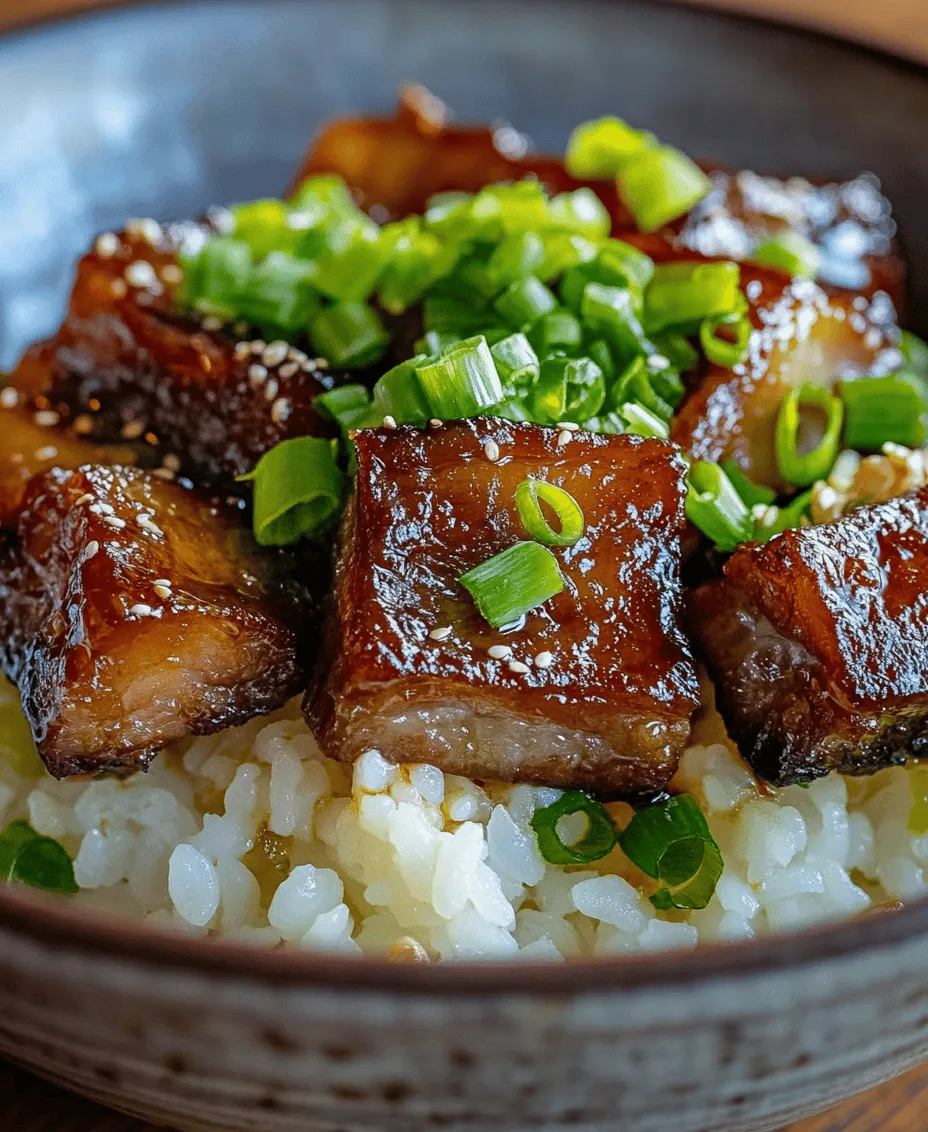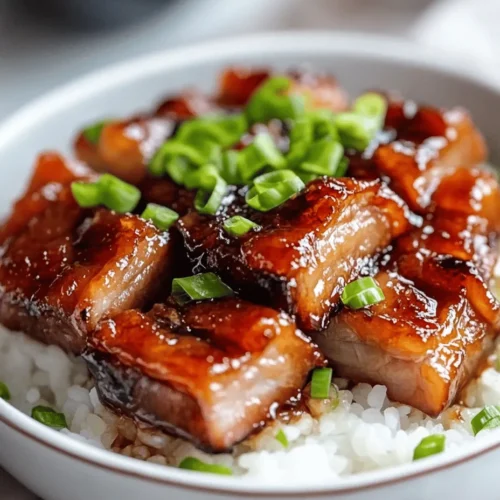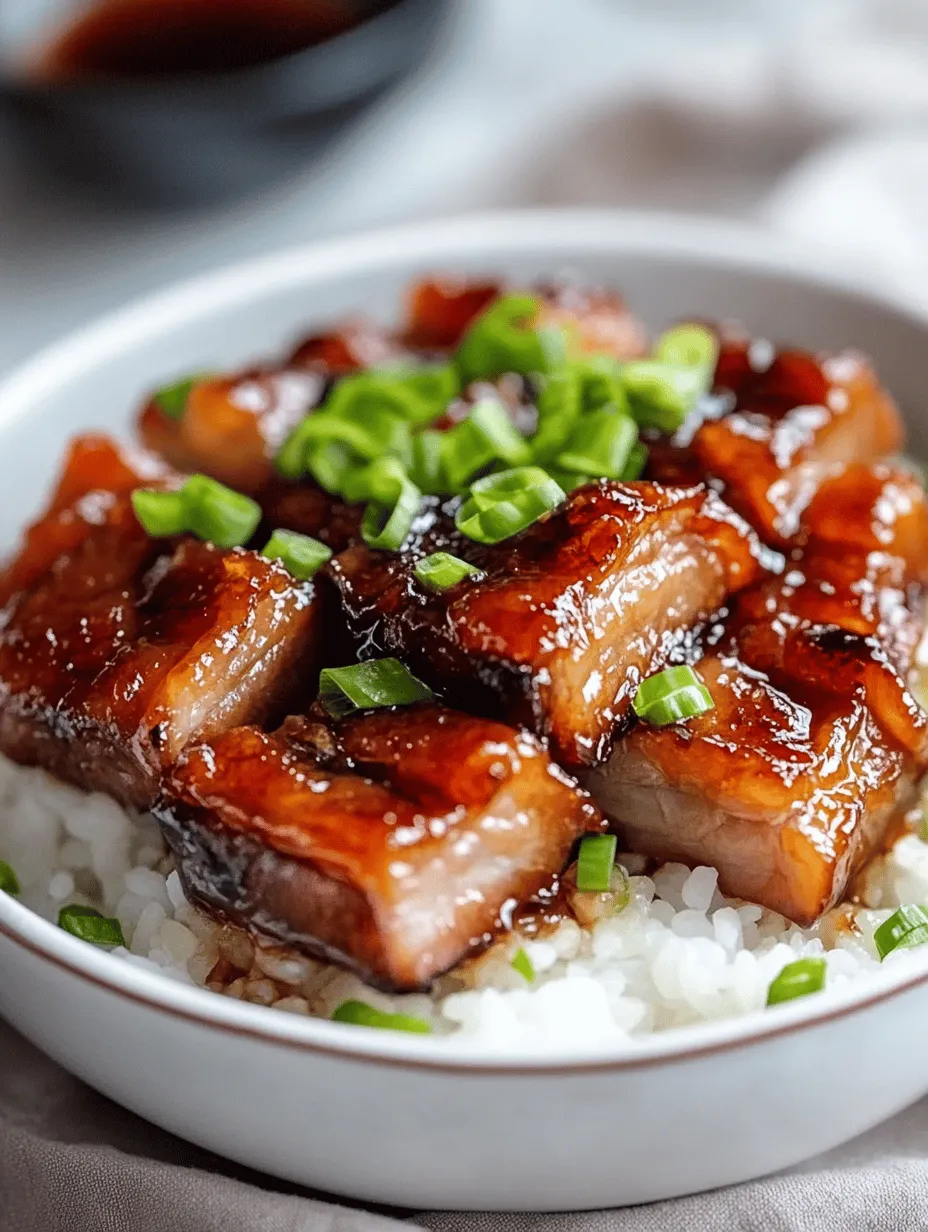Introduction
Sake-and-Soy-Braised Pork Belly is a dish that embodies the essence of Japanese home cooking. Known as “Buta no Kakuni” in Japan, this savory delicacy is a beloved staple that showcases the harmonious balance of flavors that Japanese cuisine is famous for. The dish features succulent pieces of pork belly that are slow-cooked in a rich, umami-laden sauce made from sake, soy sauce, mirin, and a hint of sweetness from brown sugar. As the pork belly braises, it transforms into tender bites that melt in your mouth, making it a comfort food favorite for many.
The cultural significance of Sake-and-Soy-Braised Pork Belly cannot be understated. It often appears during family gatherings, celebrations, and special occasions in Japan, where it is served alongside fragrant rice and seasonal vegetables. This dish not only nourishes the body but also brings people together, symbolizing warmth, love, and tradition. Its ability to evoke feelings of nostalgia and comfort is what makes it so appealing to a wide audience, transcending culinary boundaries.
For those looking for a dish that combines depth of flavor with a satisfying texture, Sake-and-Soy-Braised Pork Belly is an exceptional choice. The tender meat, infused with the rich tastes of sake and soy sauce, creates a symphony of flavors that tantalizes the palate. Whether enjoyed on a chilly evening or as part of a festive meal, this dish is sure to impress and satisfy your culinary cravings.
Understanding the Ingredients
To create the perfect Sake-and-Soy-Braised Pork Belly, it’s essential to focus on the quality and characteristics of the ingredients involved. Each component plays a significant role in developing the dish’s flavor profile and texture.
Pork Belly: Texture and Flavor Profile
Pork belly is the star of this recipe, known for its exquisite flavor and rich, fatty layers. This cut of meat comes from the underside of the pig and is renowned for its tenderness and juiciness. When cooked slowly, the fat renders beautifully, infusing the meat with moisture and flavor. This unique texture—crispy on the outside and melt-in-your-mouth tender on the inside—makes pork belly an ideal candidate for braising. It absorbs the flavors of the braising liquid, creating a deliciously rich dish.
Sake: Importance in Flavor Development
Sake, a traditional Japanese rice wine, is a crucial ingredient in this dish. Not only does it contribute to the overall flavor profile, but it also helps tenderize the meat. The alcohol in sake evaporates during cooking, leaving behind a subtle sweetness and depth that enhances the other flavors in the dish. Moreover, sake contains amino acids that promote umami, the savory taste that is a hallmark of Japanese cuisine.
Soy Sauce: The Umami Factor
Soy sauce is another essential ingredient that adds a salty, savory element to the braising liquid. Its deep, complex flavor contributes significantly to the overall umami experience of the dish. The use of high-quality soy sauce can elevate the dish, providing a robust base that complements the sweetness of other ingredients. Opting for a naturally brewed soy sauce will yield the best results, as it is richer in flavor and less processed than its mass-produced counterparts.
Mirin: Sweetness and Depth
Mirin is a sweet rice wine that balances the saltiness of soy sauce with its own gentle sweetness. It adds a layer of complexity to the braising liquid and helps to create a glossy finish on the pork belly. Mirin is a staple in Japanese cooking and is often used in marinades, glazes, and sauces. Its unique flavor can elevate the overall taste of the dish, making it a vital component in achieving the perfect balance of flavors.
Brown Sugar: Balancing Flavors
Brown sugar plays the role of a sweetener in this dish, enhancing the natural flavors of the pork belly while adding a touch of caramelization during cooking. The molasses content in brown sugar adds depth and richness, complementing the umami notes of the soy sauce and the sweetness of mirin. The combination of these flavors helps to create a sauce that is both savory and sweet, resulting in a well-rounded dish.
Ginger and Garlic: Aromatic Enhancements
Aromatic ingredients like ginger and garlic are essential for enhancing the flavors of Sake-and-Soy-Braised Pork Belly. Ginger adds a warm, spicy note that brightens the dish, while garlic provides a savory depth that rounds out the flavor profile. Together, they create a fragrant base that elevates the overall experience of the dish. Fresh ginger and garlic should be used for the best results, as their natural oils and flavors will infuse the braising liquid more effectively.
Importance of Quality Ingredients for Best Results
When it comes to preparing Sake-and-Soy-Braised Pork Belly, the quality of the ingredients can make a significant difference in the final outcome. Using fresh, high-quality pork belly, authentic sake, and artisanal soy sauce can elevate this dish from ordinary to extraordinary. The flavors of each ingredient will meld beautifully, resulting in a rich and flavorful braise that will leave a lasting impression on anyone who tastes it.
Preparation Steps Explained
Now that you understand the importance of each ingredient, let’s delve into the preparation steps involved in making Sake-and-Soy-Braised Pork Belly. Each step is crucial for achieving that tender, flavorful result that this dish is known for.
Preparing the Pork Belly
To begin, select a good-quality pork belly from your local butcher or grocery store. The pork belly should have a good balance of meat and fat, ensuring a tender and juicy outcome. Before cooking, it’s essential to prepare the pork belly properly.
1. Drying the Pork Belly: Start by patting the pork belly dry with paper towels. This step is vital, as removing excess moisture will help achieve a beautiful sear on the meat, contributing to its overall flavor and texture.
2. Scoring the Skin: Using a sharp knife, carefully score the skin of the pork belly in a crosshatch pattern. Be cautious not to cut too deeply into the meat; you only want to cut through the skin and fat layer. Scoring helps the fat render during cooking, allowing the flavors to penetrate the meat more effectively.
3. Importance of Drying and Scoring: Drying and scoring the pork belly are essential steps in enhancing the flavor absorption during the braising process. The scores allow the braising liquid to seep into the meat, while also helping to crisp up the skin when seared properly.
Searing the Pork Belly
The next step involves searing the pork belly to develop a beautiful golden crust. This process adds layers of flavor and texture to the dish.
1. Heating the Skillet: In a heavy-bottomed skillet or Dutch oven, heat a small amount of oil over medium-high heat. A heavy-bottomed pan is crucial, as it distributes heat evenly and helps prevent burning.
2. Searing the Pork Belly: Once the oil is hot, carefully place the pork belly skin-side down into the skillet. Allow it to sear without moving it for about 5-7 minutes, or until the skin is crispy and golden brown. Flip the pork belly over to sear the other side for an additional 5 minutes.
3. Techniques for Achieving Crispy Skin: To ensure maximum crispiness, you may press down on the pork belly gently with a spatula while it sears. This technique helps to render the fat from the skin, resulting in a delightful crunch.
Creating the Braising Liquid
After searing the pork belly, it’s time to create the flavorful braising liquid that will infuse the meat with its deliciousness.
1. Sautéing Ginger and Garlic: Remove the seared pork belly from the skillet and set it aside. In the same skillet, add a little more oil if needed, and toss in minced ginger and garlic. Sauté them for about 30 seconds, or until fragrant, taking care not to burn them.
2. Adding Liquids and Building Flavor: Next, pour in the sake, soy sauce, mirin, and water. Scrape the bottom of the skillet with a wooden spoon to release any browned bits from searing the pork belly, as these bits add extra flavor to the braising liquid. Stir in brown sugar until it dissolves completely.
3. The Role of Each Ingredient in the Braising Liquid: Each ingredient in the braising liquid plays a vital role in creating the dish’s signature flavor. The sake tenderizes the meat, soy sauce adds umami, mirin introduces sweetness, and brown sugar balances the overall taste. The combination of these ingredients creates a complex and deeply flavorful sauce that will seep into the pork belly.
4. Importance of Simmering for Flavor Integration: Once the braising liquid is prepared, return the seared pork belly to the skillet, ensuring that it is mostly submerged. Bring the mixture to a gentle simmer, then cover the pot with a lid. Allow the pork belly to braise for at least two hours on low heat, or until the meat is fork-tender. This slow cooking method allows the flavors to meld beautifully while ensuring the pork belly remains moist and flavorful.
By following these preparation steps, you are well on your way to creating a delectable Sake-and-Soy-Braised Pork Belly that will impress anyone who has the pleasure of tasting it. This dish is a wonderful representation of Japanese culinary traditions, showcasing the balance of flavors and textures that make it such a beloved comfort food. Stay tuned for the next part of the article, where we will delve further into final cooking tips and serving suggestions for this exquisite dish.

The Braising Process
Braising is a cooking technique that combines both moist and dry heat, ideal for transforming tough cuts of meat into tender, flavorful dishes. For Sake-and-Soy-Braised Pork Belly, this method is crucial because it allows the rich flavors of sake and soy sauce to permeate the meat while breaking down the connective tissues. Start by heating a heavy pot or Dutch oven over medium heat. Add a small amount of oil, and when it shimmers, place the pork belly in the pot skin-side down.
Temperature Control and Timing for Optimal Tenderness
Once the pork belly is seared to a deep golden brown, you can lower the heat to a gentle simmer. The key to perfect braising is maintaining a consistent, low temperature. Aim for a temperature between 180°F to 200°F (82°C to 93°C). This slow cooking process allows the fat to render out, keeping the meat moist and tender. You will typically braise the pork belly for about 2 to 3 hours, depending on the thickness of your slices.
Importance of Turning the Pork Belly During Cooking
To ensure even cooking and flavor distribution, it is vital to turn the pork belly pieces every 30 minutes. This simple step will help the meat absorb the braising liquid’s flavors while preventing any part from drying out. Use tongs to gently turn each piece, making sure the skin remains submerged in the liquid.
How Long to Braise for Perfect Results
For ideal results, allow the pork belly to braise for 2 to 2.5 hours. At this point, the meat should be fork-tender, with a rich, glossy appearance. If you have thicker cuts, you may need to extend the cooking time up to 3 hours. The goal is to achieve a melt-in-your-mouth texture that will leave your guests craving more.
Explanation of the Science Behind Braising
The science behind braising lies in the combination of moisture and heat. During the cooking process, collagen in the pork belly breaks down into gelatin, which enriches the braising liquid, adding body and flavor. As the fat renders, it further enhances the dish’s richness. This slow cooking method also allows flavors to develop and deepen over time, resulting in a final dish that is much greater than the sum of its parts.
Finishing Touches
Once the pork belly has reached the desired tenderness, it’s time to focus on the finishing touches that will elevate your dish.
Resting the Pork Belly
After removing the pork belly from the pot, let it rest for at least 15 minutes. This step is crucial for texture; resting allows the juices to redistribute throughout the meat, ensuring that each bite remains juicy and flavorful.
Why Resting is Crucial for Texture
Resting meat after cooking is essential because it prevents the juices from running out when you slice into it. If you skip this step, you may end up with a dry dish that lacks flavor. Give your pork belly time to settle before moving on to the next steps.
Reducing the Braising Liquid
While the meat rests, strain the braising liquid into a saucepan, discarding any solids. Place the liquid over medium-high heat and bring it to a simmer. Allow it to reduce until it reaches a syrupy consistency, which should take about 10-15 minutes. This concentrated sauce is what will coat your pork belly, enhancing its flavor and creating a beautiful glaze.
Techniques for Achieving the Right Consistency
To achieve the perfect sauce consistency, monitor the reduction process closely. You can whisk in a bit of cornstarch slurry (equal parts cornstarch and water) if you prefer a thicker sauce. Just be sure to bring it to a brief boil after adding to fully activate the thickening properties.
Tips for Balancing Flavors in the Sauce
As you reduce the sauce, taste it regularly and adjust the flavors as necessary. If it feels too salty from the soy sauce, add a tiny splash of rice vinegar or a pinch of sugar to balance it out. The goal is to create a harmonious blend of salty, sweet, and umami flavors that complement the richness of the pork belly.
Serving Suggestions
Presentation is key when serving Sake-and-Soy-Braised Pork Belly. Here are some tips to help you create an appealing dish.
Presentation Tips for an Appealing Dish
Slice the pork belly into thick pieces and arrange them on a serving platter. Pour the reduced braising liquid over the meat and garnish with finely sliced scallions. For a pop of color and freshness, consider adding a sprinkle of sesame seeds or a few slices of pickled ginger.
Ideal Accompaniments: Freshly Steamed Rice and Optional Sides
This dish pairs beautifully with freshly steamed jasmine or sushi rice. The rice acts as a perfect canvas, soaking up the delicious braising liquid. For additional sides, consider serving pickled vegetables, steamed bok choy, or a light cucumber salad. These complementary flavors will balance the richness of the pork belly.
Garnishing with Scallions: Enhancing Flavor and Aesthetics
Finishing your dish with scallions not only enhances the visual appeal but also adds a fresh, sharp flavor that cuts through the richness of the pork. Sprinkle them generously over the top before serving, and encourage your guests to enjoy the dish with a dash of the reduced sauce.
Nutritional Information
When enjoying Sake-and-Soy-Braised Pork Belly, it’s essential to consider its nutritional benefits. This dish is rich in protein, which is vital for muscle repair and growth. The pork belly offers healthy fats that can be part of a balanced diet when consumed in moderation.
Overview of Nutritional Benefits of the Dish
A typical serving of pork belly provides a substantial amount of protein, essential vitamins, and minerals, including zinc and B vitamins. The addition of rice contributes carbohydrates that provide energy, making this dish a hearty meal option.
Highlighting Balance in a Meal with Protein and Carbs
For a well-rounded meal, consider incorporating a variety of vegetables alongside the pork belly and rice. This will not only enhance the nutritional profile but also add color and texture to your plate. Aim for a balanced plate that includes protein from the pork, carbohydrates from the rice, and fiber from vegetables.
Cultural Context
Pork belly is a beloved ingredient in many cuisines around the world, but its significance in Japanese cooking is particularly noteworthy. This dish represents a traditional Japanese approach to cooking, where the focus is on enhancing the natural flavors of the meat through careful preparation and seasoning.
The Role of Pork Belly in Various Cuisines
In addition to its popularity in Japan, pork belly is a staple in Chinese, Korean, and Filipino cuisines. Each culture has its unique preparations and flavors, showcasing the versatility of this cut of meat. Whether it’s served in a rich stew or grilled, pork belly continues to be a favorite for its tenderness and flavor.
How This Dish Represents Traditional Japanese Cooking Practices
Sake-and-Soy-Braised Pork Belly embodies the essence of traditional Japanese cooking, which celebrates umami flavors and the natural sweetness of ingredients. The use of sake not only enhances the dish’s flavor profile but also reflects the Japanese culinary philosophy of balancing flavors and textures.
Significance of Sake in Japanese Culinary Culture
Sake, a fermented rice beverage, holds a special place in Japanese culture. It is often used in cooking to enhance flavors, tenderize meats, and add depth to sauces. The use of sake in this braising recipe not only highlights its importance but also adds a layer of complexity that elevates the dish.
Conclusion
Sake-and-Soy-Braised Pork Belly is a dish that captivates not only with its rich flavors and melt-in-your-mouth texture but also with its cultural roots in Japanese culinary traditions. The careful process of braising allows the pork to become tender while absorbing the aromatic flavors of sake and soy sauce, resulting in a comforting meal that can be enjoyed by all.
As you embark on the journey of making this delightful dish at home, remember that cooking is about sharing joy and creating memories with loved ones. The satisfaction of preparing a meal that resonates with both the heart and the palate is immeasurable. We encourage you to try this recipe and experience the comforting flavors of Sake-and-Soy-Braised Pork Belly for yourself. Happy cooking!



